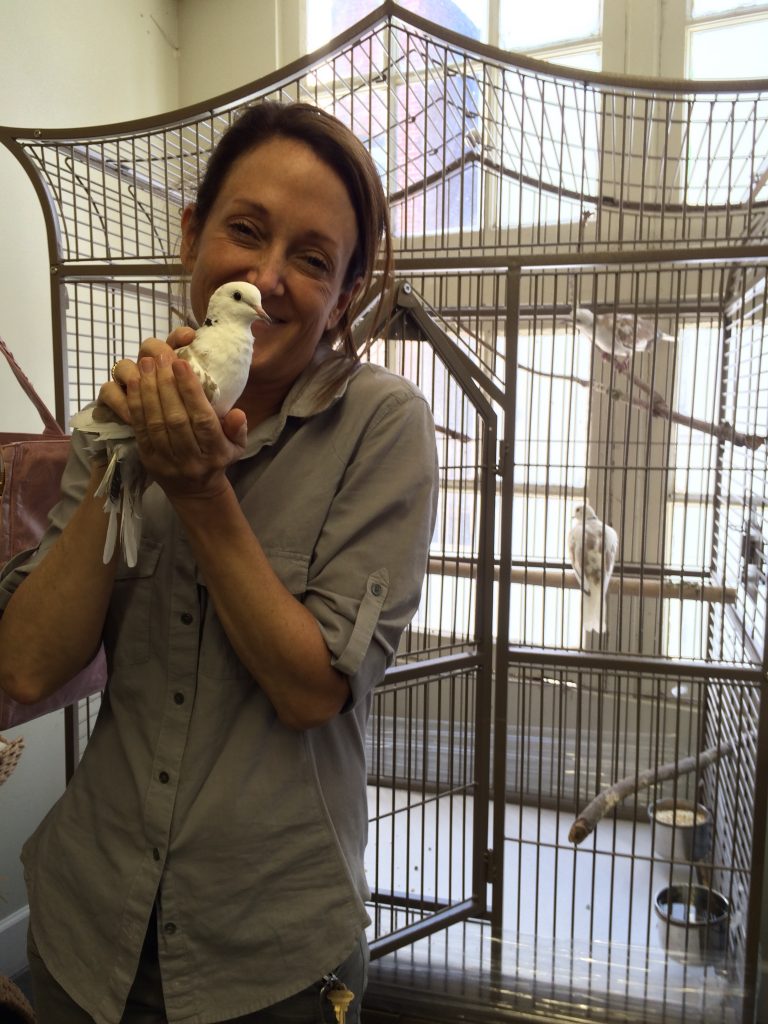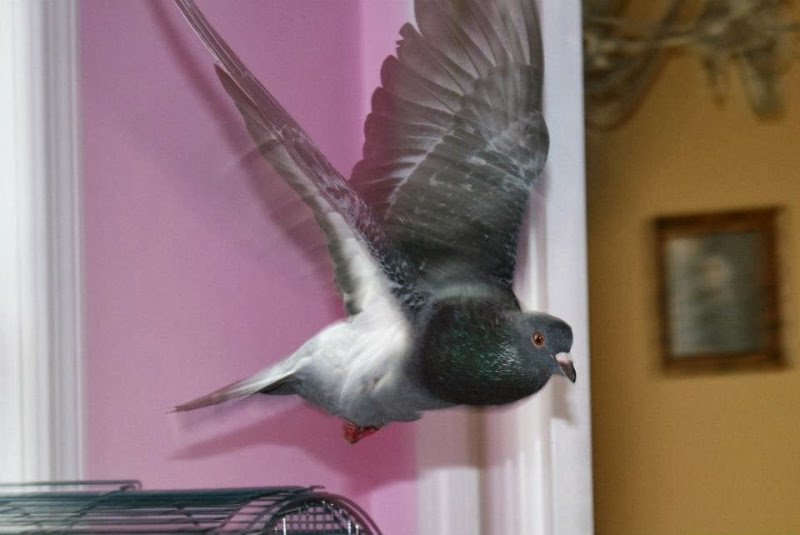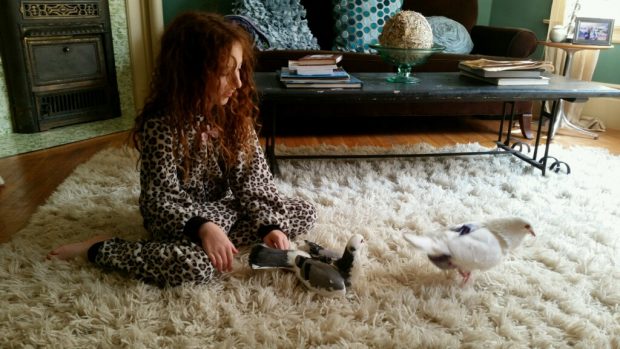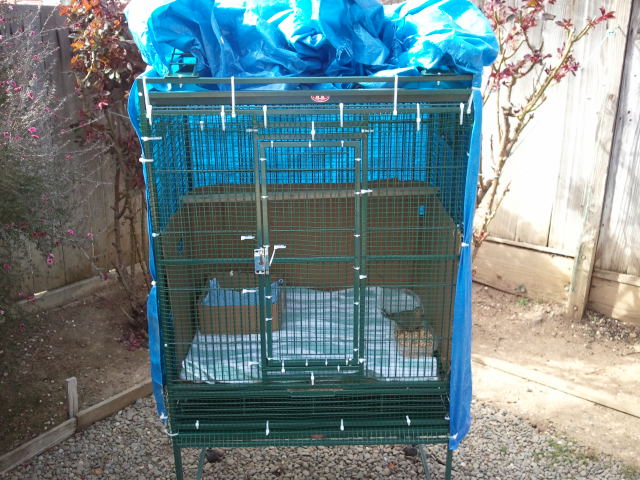If I had my way, there would be no pet pigeons or doves. They would all be wild and free. I don’t believe that birds should be domesticated, bred and used by people for any reason. But, because people do breed, use and lose unreleasable pigeons and doves, there are a great many in need of rescue and homes. I’m writing this for those birds and the compassionate people who save their lives through rescue and adoption.
This article is focused just on cages. You can learn more about pigeons as pets here, more about doves here and more about how to create an aviary here.
Pigeons and doves do great indoors as family pets. They can also live outside in a predator & rodent-proof aviary but I would never make a single bird live outside alone. Pigeons and doves are flock birds and to be outside alone is stressful and lonesome. A single pigeon or dove living indoors adopts the people as flock members. Please note, if your bird is going to be outside (even temporarily), she must be in a predator-proof cage. Most bird cages are designed only to keep birds confined indoors and they are not predator-proof outside. (To be predator-proof, the cage must be sturdily built, have very narrow spacing between bars & raccoon-proof latches. If in doubt, get expert guidance. Your birds’ lives depend on it.)
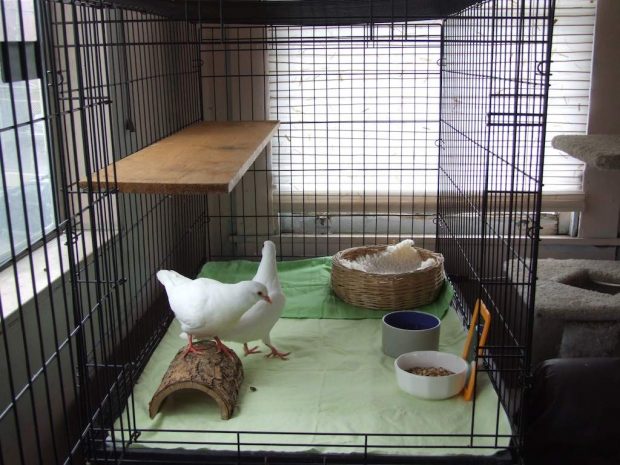
A large dog crate is a good indoor cage for 1-2 pigeons but because of the wide bar spacing is NOT SAFE OUTSIDE!
Rescued or adopted indoor pet pigeons and doves need an appropriate cage as their home base and safe place if they are living in the house. They also need safe, daily out-of-cage time in the house to exercise and socialize. Learn about pigeon pants here. (It’s unsafe to free fly domestic pigeons and doves outside in a wild environment. They are easy prey for predators including hawks, ravens, gulls, cats, dogs, raccoons, etc.)
The bigger the cage the better and length or width are more important than height (pigeons and doves don’t climb like parrots). We recommend a minimum cage size of 42″ wide, 27″ deep, 30″ high for one or two (mated) pigeons and 32″ wide, 32″ high and 21″ deep for one or two doves.
To be pigeon and dove friendly, the bottom should be covered with something easy to clean and flat such as wood, linoleum, plastic or a yoga mat cut to size. (Pigeons and doves should never have to stand on a wire cage bottom. It is uncomfortable and unhealthy for their feet!) The cage should include some shelves to offer destinations to fly to and hang out on. (Perches are less useful for pigeons and doves- all you can do on a perch is stand or sit. Shelves offer more options including strutting, courting, lounging, napping, etc.) Include a nice big mirror and a basket (weighted so as not to tip) or nest box. Use heavy, ceramic flat bottom, straight-sided crocks for food and water (I get them at thrift stores). Provide a casserole dish or big plant saucer for a bath tub. Locate their cage in a well-lit area (they have poor vision in low light and even bright homes are dim compared to the outside). They’ll also need safe access sunshine unfiltered by glass or avian-safe full spectrum lighting. Locate them where they can be near the family (for companionship and entertainment). Don’t worry about drafts- that’s a non-issue, the more fresh air, the better. Do study up though on true household hazards for pet birds such as using Teflon-coated pans, smoke, scented and aerosole products, open windows or doors, hot stoves, ceiling fans, etc. (See Top Ten Household Dangers to Pet Birds and Bird Proof Your Home, though they recommend clipping wings and we don’t. Please note: CLIPPED WINGS ONLY PREVENT BIRDS FLYING INDOORS. CLIPPED-WING BIRDS CAN AND DO GET AIRBORNE AND LOST OUTSIDE ALL OF THE TIME!)
The cage needs to be up to the task of protecting them from the predators that have access to the cage. If you don’t have cats or dogs in the home wanting to reach in through the bars, wide spacing like that of dog crates is fine for pigeons (though not for doves who can fit right through).
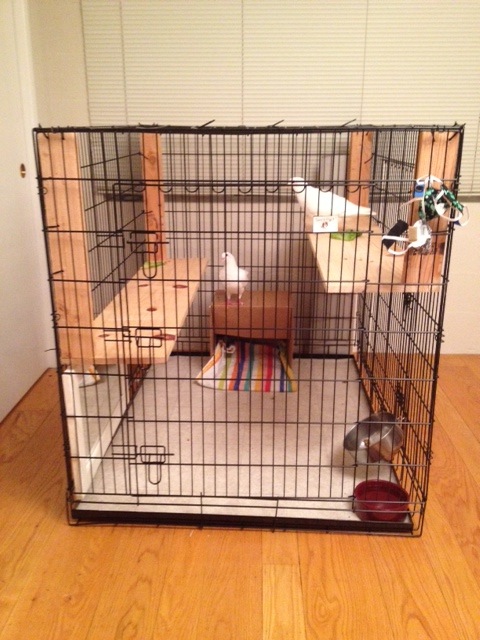
Shelves are easy to install and provide destinations & hangouts. Pigeons need daily safe out-of-cage time to exercise & socialize. (NOT SAFE OUTSIDE)
An enclosure with wide spaced bars is not safe outside though- not even for short periods of time. (Predators are hungry, alert and strike fast!)
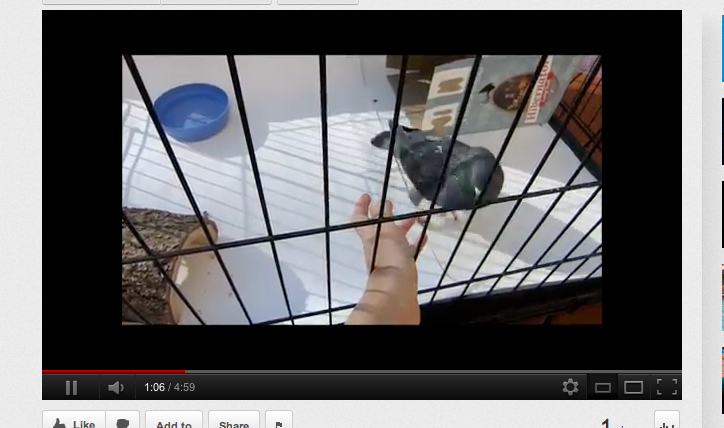
Predators such as cats, hawks, ravens, raccoons, rats, gulls, etc. kill pigeons kept outside in crates or cages with widely-spaced bars. (NOT SAFE OUTSIDE)
If you do have dogs and cats in the home, you’ll need more-closely spaced cage bars to keep pets’ paws and snouts out. (Note that while indoor cages like this are usually adequate to keep pet birds safe from well fed household pets, they are too lightly constructed to protect against hungry, wild predators!)
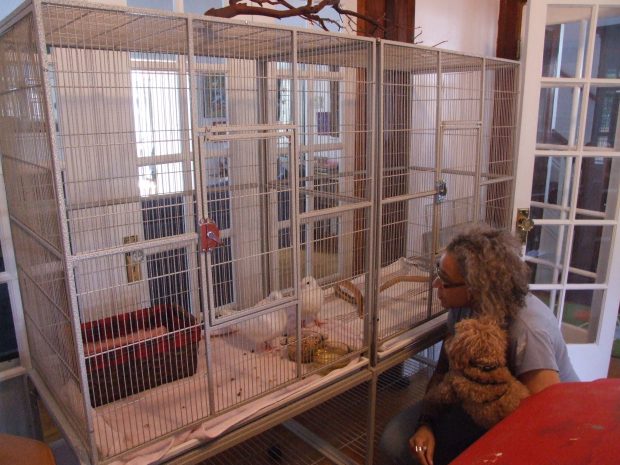
A double-flight cage (64” l X 21″ w X 36″h) is a great indoor cage for 1-2 pigeons or 2-4 doves. This one needs shelves installed. (NOT SAFE OUTSIDE)
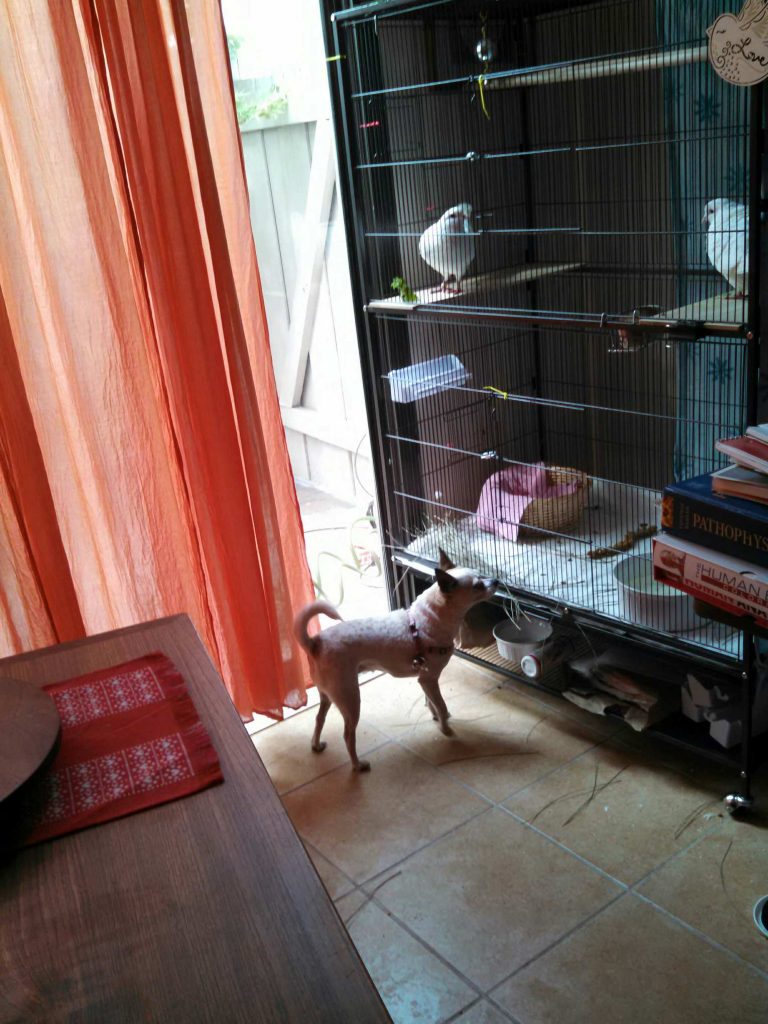
This large flight cage has narrow bar spacing to keep cats & dogs’ out, small doors are zip-tied to guard against clever cat paws and includes shelves as destinations. (NOT SAFE OUTSIDE)
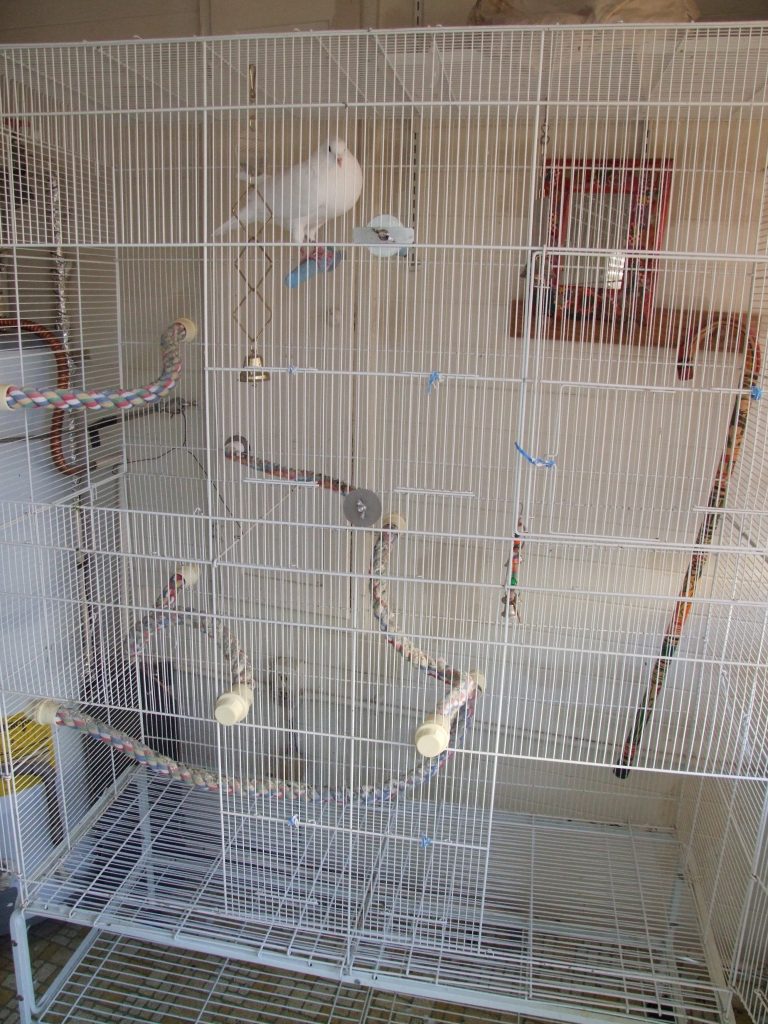
This cage is OK indoors (good height and length, not wide enough for a big pigeon like this King) but not set up well for a pigeon. Pigeons prefer shelves to perches and should never have to stand on bare wire. (NOT SAFE OUTSIDE)
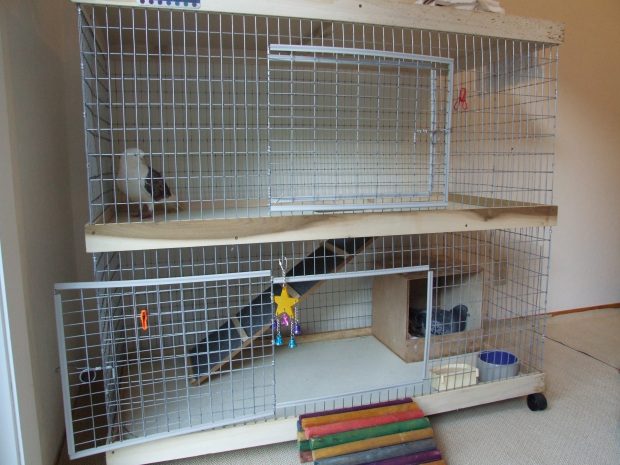
A double-decker bunny condo can be a good indoor cage for 1-2 pigeons or 2-4 doves (NOT SAFE OUTSIDE)
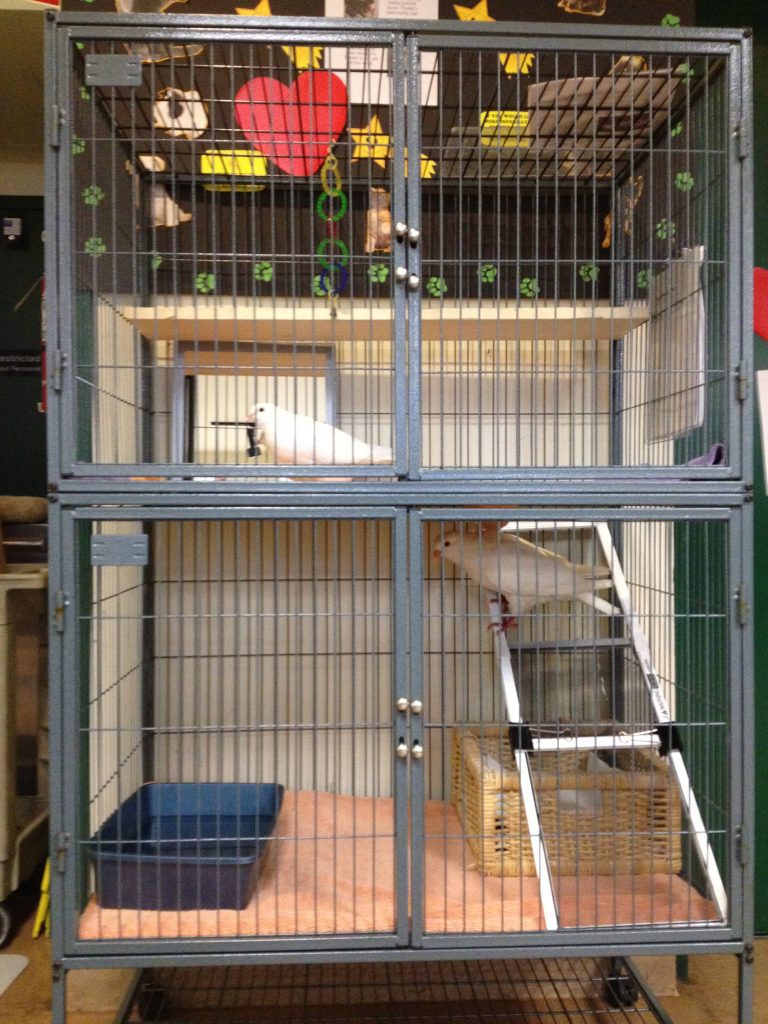
A large double-decker small animal cage can be a good indoor cage for 1-2 pigeons. Note the good pigeon furnishings including a shelf, mirror, ramp, basket & bath tub. (NOT SAFE OUTSIDE)
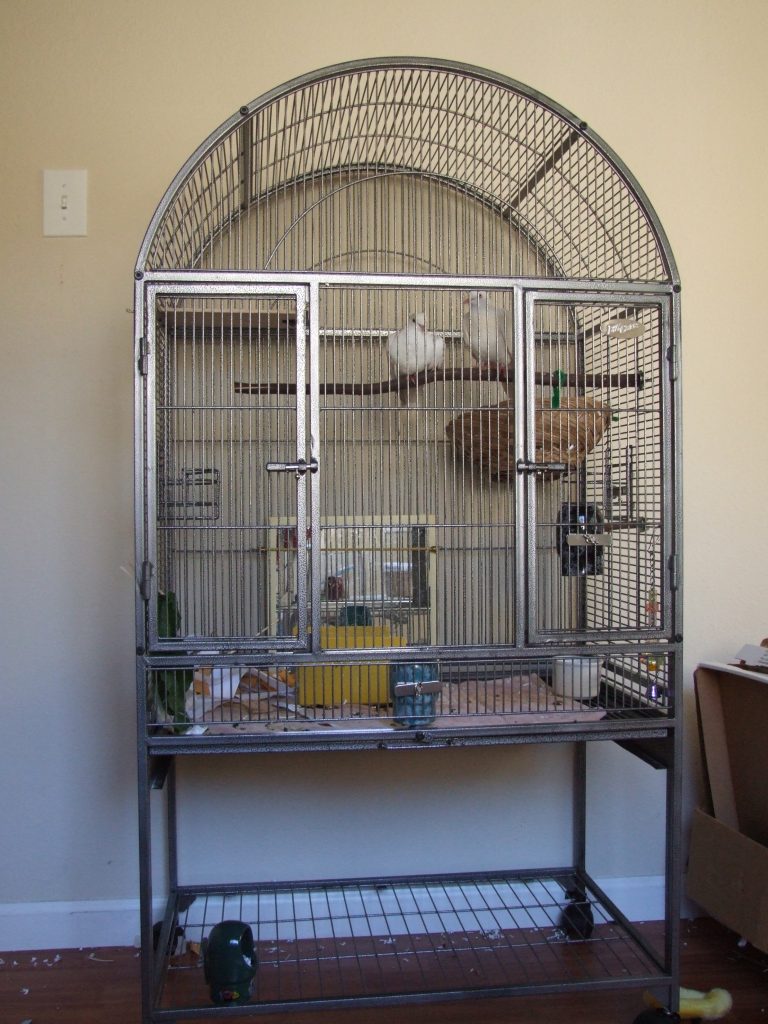
This flight cage makes a great indoor cage for 1-2 doves provided they get daily, safe out of cage time to exercise and socialize. (NOT SAFE OUTSIDE)
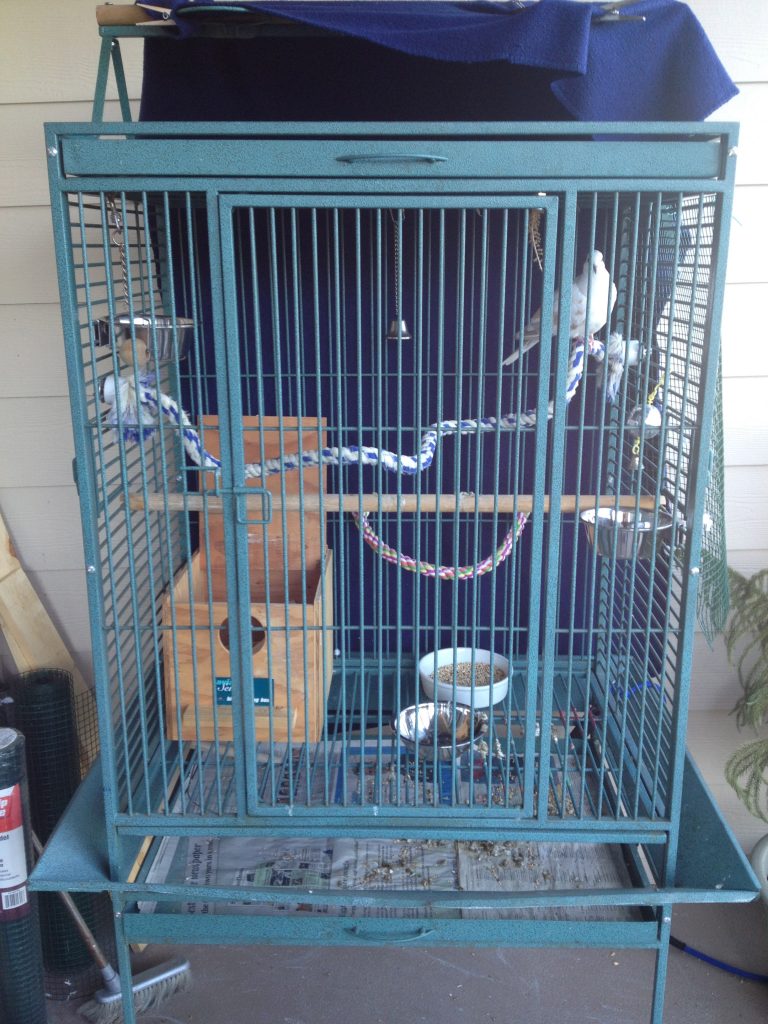
A parrot cage can make a nice home for 1-2 doves but this is NOT SAFE OUTSIDE because of the too-wide bar spacing. Also doves shouldn’t have to stand on bare wire. Cover their cage floor with wood, linoleum, a yoga mat trimmed to fit, etc. (Something easy to clean and comfortable for their feet.)
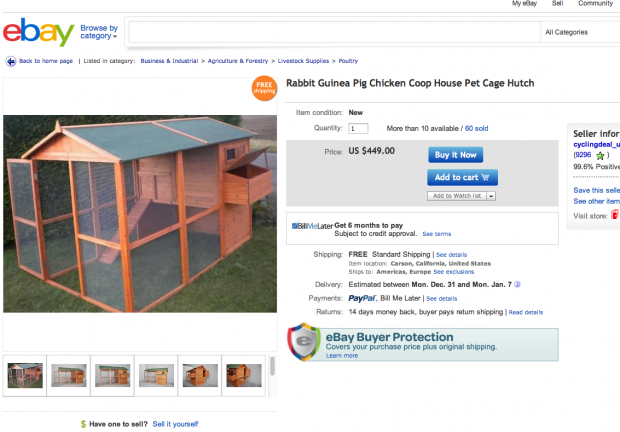
Don’t assume enclosures sold for outside use are safe! Without the addition of a predator & rodent-proof bottom and raccoon-proof latches on all the doors, this could be a death trap for any animal housed inside. (BUYER BEWARE)
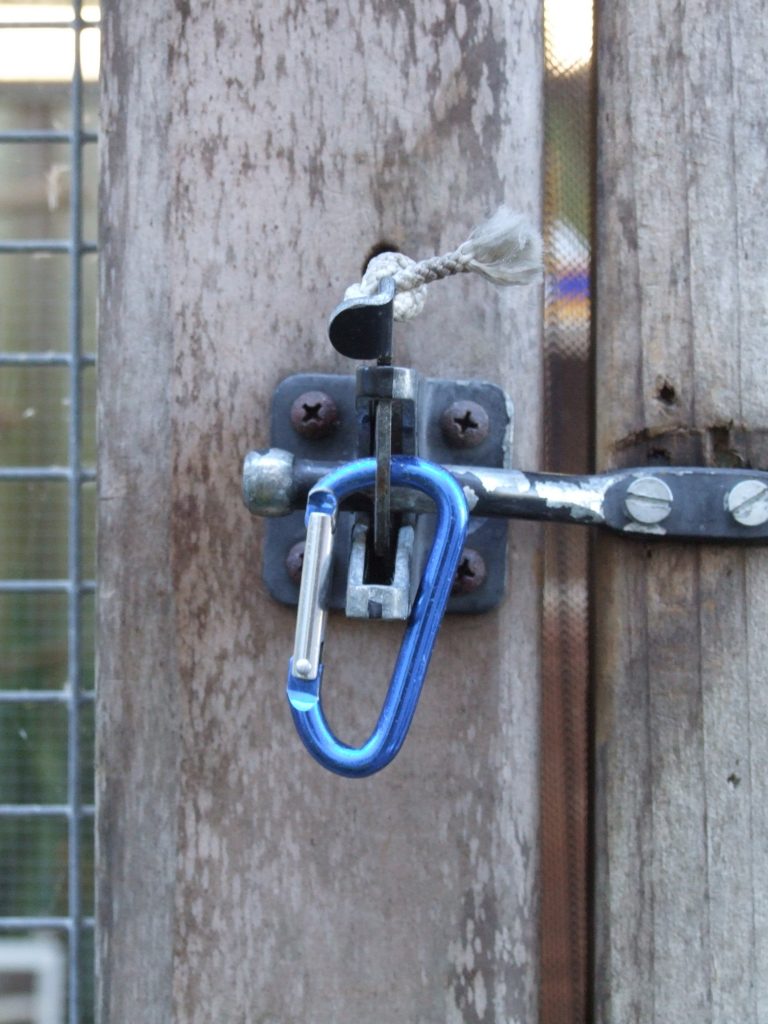
Take care to ensure that all latches are raccoon-proofed! They are clever, motivated, dexterous and deadly.
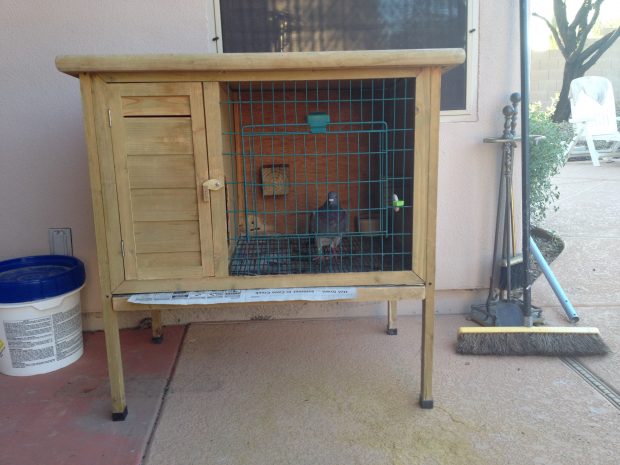
This lost survior of pigeon racing was rescued and his finder purchased this small animal hutch as emergency housing, trusting that since it was designed for outside use, it would be safe. It’s NOT OUTSIDE SAFE. They immediately modified it to make it safe and then set to work building an aviary.
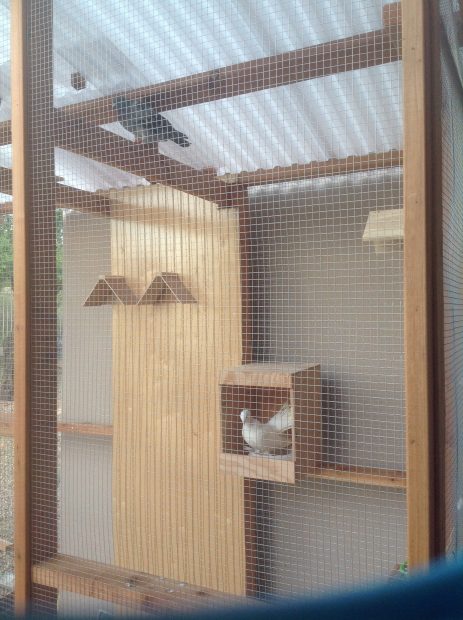
Aviary built to be pigeon-friendly and predator & rodent-proof for rescued racing pigeon & friends. (SAFE OUTSIDE)
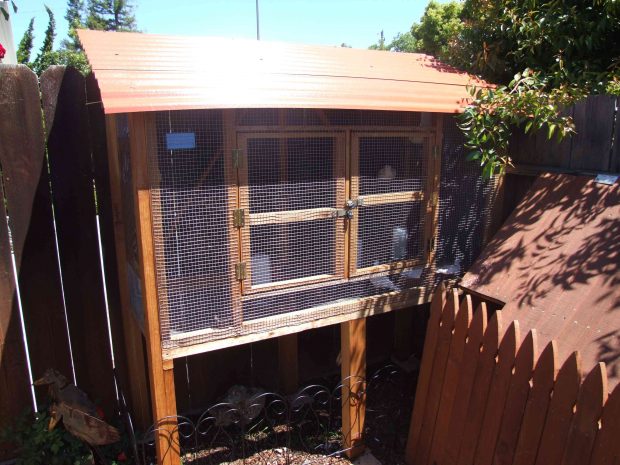
This dove avairy was built to be predator & rodent-proof and is so long as the latches are always closed with raccoon-proof locks or carabiners. SAFE OUTSIDE
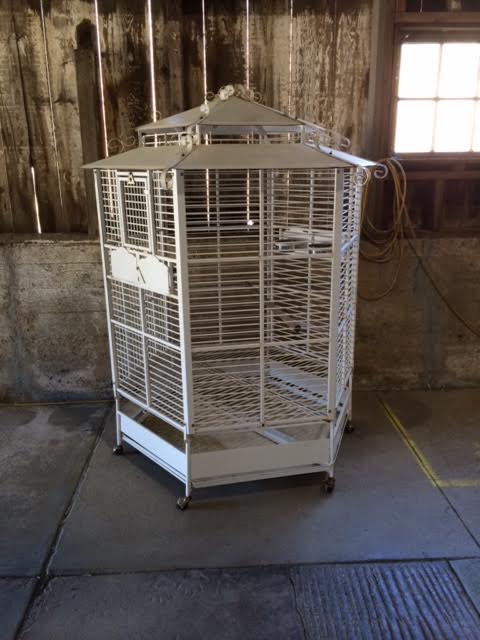
Though sold for use outside, the too-wide bar spacing makes it unsafe (unless modified) for outside use. It would be a good size for 4 doves and it is sturdy. (NOT SAFE OUTSIDE)

This flight cage, designed to be used outside, is predator & rodent-proof and a good size for 2 pigeons or 4 doves. SAFE OUTSIDE
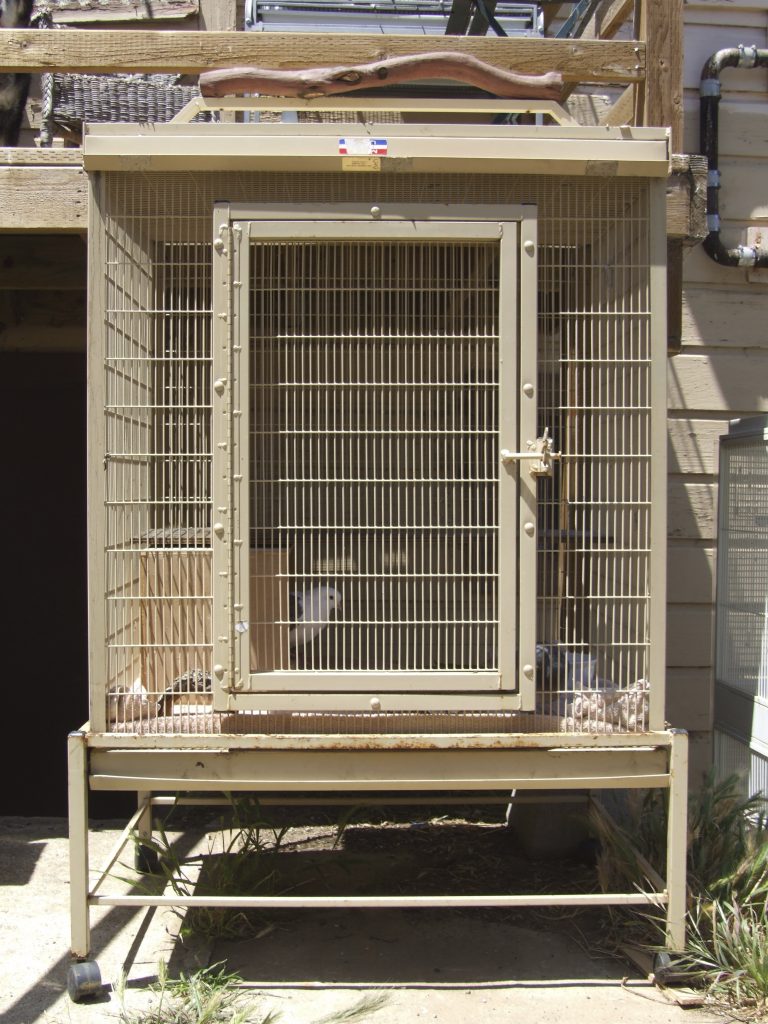
While this cage is safe outside (sturdily built, narrow bar-spacing, raccoon-proofed latch) it is not big enough to live in without being brought indoors for safe out-of-cage time. SAFE OUTSIDE
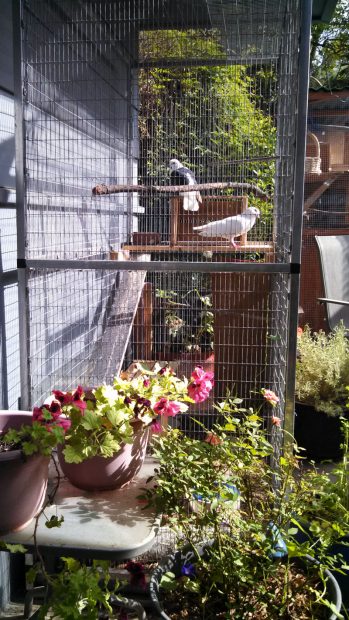
This flight cage is built for outside use (sturdy with strong bars, narrow bar spacing, an attached floor, no gap larger than .5″ and a raccoon-proof latch) and is approved as SAFE OUTSIDE
Please see How to Create an Aviary for Rescued Pigeons or Doves for more info about keeping pigeons & doves as pets outside.
And please, if you’re not sure about the safety or appropriateness of a cage or aviary, share photos with an expert and get guidance. Your birds’ lives depend on it! Here’s a map of just a few of the pigeon and dove-friendly rescues in the US. (There are more out there, we’re just starting to populate this map). There are also pigeon rescue groups on Facebook such as Pigeon & Dove Rescue International and ours- Palomacy Pigeon & Dove Adoptions. Post photos of the cage and your questions and you’ll get help.
Our pets depend on us for their everything- their safety, their happiness, their lives. Take good care of them. They are the angels among us.

